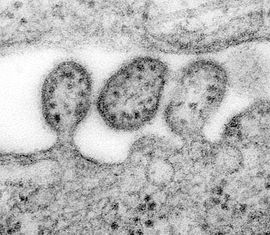Arenaviridae
 Lassa virus z čeledi Arenaviridae | |
| Baltimorova klasifikace virů | |
| Skupina | V (ssRNA viry s negativní polaritou) |
| Vědecká klasifikace | |
| Realm | Riboviria |
| Říše | Orthornavirae |
| Kmen | Negarnaviricota |
| Podkmen | Polyploviricotina |
| Třída | Ellioviricetes |
| Řád | Bunyavirales |
| Čeleď | Arenaviridae |
| Rod | |
| |
| Některá data mohou pocházet z datové položky. | |
Arenaviridae je čeleď RNA virů V. skupiny, která není podle současných znalostí zařazena do žádného řádu. Jde o ssRNA obalené viry s negativní polaritou.
Obsahuje čtyři rody Antennavirus, Hartmanivirus, Mammarenavirus, Reptarenavirus,[1] z nichž poslední dva byly dříve považované za jediný rod Arenavirus. Jeho zástupci jsou známí především jako původci závažné hemoragické (krvácivé) horečky Lassa.
Reference
- ↑ International Committee on Taxonomy of Viruses, Virus Taxonomy: 2019 Release. Dostupné online Archivováno 2. 5. 2020 na Wayback Machine. (anglicky)
Externí odkazy
 Obrázky, zvuky či videa k tématu Arenaviridae na Wikimedia Commons
Obrázky, zvuky či videa k tématu Arenaviridae na Wikimedia Commons  Taxon Arenaviridae ve Wikidruzích
Taxon Arenaviridae ve Wikidruzích- Schéma viru na webu Viralzone (anglicky)
Média použitá na této stránce
Autor:
- Information-silk.png: Mark James
- derivative work: KSiOM(Talk)
A tiny blue 'i' information icon converted from the Silk icon set at famfamfam.com
ID#: 8699 Description: This highly magnified transmission electron micrograph (TEM) depicted some of the ultrastructural details of a number of Lassa virus virions adjacent to some cell debris. The virus, a member of the virus family Arenaviridae, is a single-stranded RNA virus, and is zoonotic, or animal-borne that can be transmitted to humans. The illness, which occurs in West Africa, was discovered in 1969 when two missionary nurses died in Nigeria, West Africa. In areas of Africa where the disease is endemic (that is, constantly present), Lassa fever is a significant cause of morbidity and mortality. While Lassa fever is mild or has no observable symptoms in about 80% of people infected with the virus, the remaining 20% have a severe multisystem disease. Lassa fever is also associated with occasional epidemics, during which the case-fatality rate can reach 50%.
Signs and symptoms of Lassa fever typically occur 1-3 weeks after the patient comes into contact with the virus. These include fever, retrosternal pain (pain behind the chest wall), sore throat, back pain, cough, abdominal pain, vomiting, diarrhea, conjunctivitis, facial swelling, proteinuria (protein in the urine), and mucosal bleeding. Neurological problems have also been described, including hearing loss, tremors, and encephalitis. Because the symptoms of Lassa fever are so varied and nonspecific, clinical diagnosis is often difficult.
Approximately 15%-20% of patients hospitalized for Lassa fever die from the illness. However, overall only about 1% of infections with Lassa virus result in death. The death rates are particularly high for women in the third trimester of pregnancy, and for fetuses, about 95% of which die in the uterus of infected pregnant mothers.
